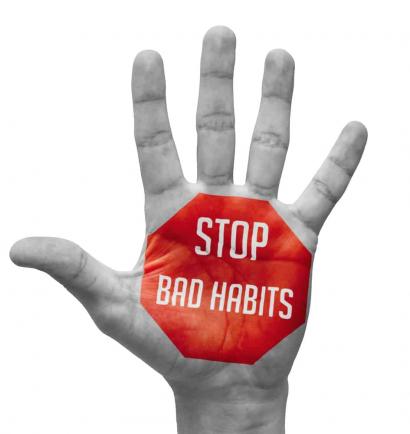
Whether you bite your hair, snack constantly, or shop till you drop, all bad habits have something in common: you don't even recognize you're doing it.
Bad habits most likely occur from one moment of weakness, which then becomes a natural habit.
Have you noticed your hair getting split ends, your stomach bulging out or your credit card bill increasing?
Here are 5 steps to take when trying to break that bad habit:
Step 1: Understand it
Habits can be developed in over 100 different ways. Understanding why and when you practice the habit is the first step to breaking it. If you are a hair biter, ask someone to help observe you and really discover when you bite your hair. Is it when you are stressed? When you are tired? Hungry?
Another reason why this first step is so crucial is because you can understand what the best tactic is for you personally in overcoming the habit. If the habit was developed 20 years ago and you are just now starting to break it, you are not likely going to overcome it in just one month; it could take a whole year for you to do so. Don't be frustrated- as long as it is the best solution for you it is the right one.
Step 2: Create a goal
Do you have a desire to quit? Once the desire is there, you can start by committing to a realistic goal. Goals encourage you to make a change. They are a constant reminder of what you hope and believe you can achieve.
American Author Tony Robbins once said, "Setting goals is the first step in turning the invisible into the visible." Just saying that you will break out of that habit by the end of the week is not realistic. Whereas writing down the overall goal and giving yourself adequate time to succeed is.
Step 3: Make a plan
The goal has been set and you are ready for a plan- great! The qualities one should attribute to a realistic goal plan are being specific, taking small steps, have dates and make it a challenge.
Start small by saying, "This week I will replace my bad habit by giving someone a compliment." The timeline is a week- it is specific, a small change and is still challenging. This is just an example of one of the many things you can choose to replace your bad habit with. Each week change it up until sooner or later you do not have to replace your bad habit because it is completely gone.
Step 4: Avoid situations that invite the bad habit
In the journal, "Breaking 'bad habits': a dynamical perspective on habit formation and change," Jager W. shares, "...avoid the circumstances in which they performed the behavior a lot." Whether this is a specific location like a bar, party, rooftop, or if it means situations that create stress, anger etc.
Step 5: Be your own motivator
A constant encouragement boost from yourself is a great way to remind yourself of the goal in sight even when it seems just out of reach. Adam Dachis broke his bad habit of biding his nails through recording himself in a webcam. He shares, "Our brains are unfortunately wired to take a large amount of comfort in our voices."
You may consider writing down a message to your 'future self' and reading it on the days that feel like years. Whatever you need to do to get through, do it.
These 5 steps can be very effective as long as the desire to change is there throughout the whole process. Nowhere was it written that challenges are easy or that habits can never before be broken.
Roman poet Ovid shared, "Nothing is stronger than habit." So why not make it a good one?

